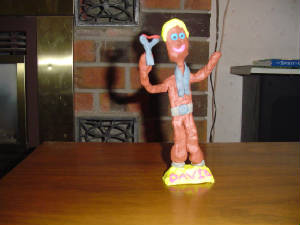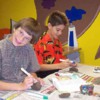David and Goliath
Art Workshop ("Creation Station")
Summary of Lesson Activity:
Students will be making decorated rock paperweights to remind them of David's real power... his choice to come out against the giant with his faith.
Scripture Reference:
1 Samuel 17:1-50
Key Scripture Verses:
1 Samuel 17:45- 46a “You’ve come out to fight me with a sword and a spear and a dagger. But I’ve come to fight you in the name of the Lord All-Powerful. He is the God of Israel’s army, and you have insulted him too. Today the Lord will help me defeat you.” (Contemporary English Version)
Memory Verse:
“Don’t ever be afraid or discouraged! I am the Lord your God, and I will be there to help you wherever you go.” Joshua 1:9 (CEV)
Concepts:
- God is with you in difficult situations.
- God gives us hope even when everything seems hopeless.
- God works in ways we do not expect and through people we do not expect.
Lesson Objectives:
- Learn that David relied on God’s power and his own simple but skilled ability rather than fancy weapons and armor to win the battle for God’s people.
- Understand that even a child can do God’s work.
- Know that David had enough faith in God to bravely face the giant Goliath.
- Children will use acrylic paint to decorate stone paperweights to remind them of David’s deeds.
Materials List:
- 2" to 4” smooth stones (these can be purchased in a home store, or from a local landscaper)
- Pencils
- Thin paintbrushes
- Cups of water to rinse brushes
- Liquid acrylic paint
- Nontoxic, fumeless paint markers “Painters”
- Paper towels
Leader Preparation:
- Read the scripture ahead of time.
- Gather the materials
- Go over the project.
Presentation:
Opening- Welcome and Introductions:
Welcome the children and introduce yourself. Wear your nametag.
Start the “lesson time” with prayer. Ask for volunteers, but plan on praying yourself. A short prayer thanking Jesus for being a part of our lives always would be appropriate.
Dig-Main Content and Reflection:
Bible Story:
David was a young boy who cared for his father’s sheep. Being a shepherd in his desert land was sometimes easy, but other times it was very dangerous. Wild animals like lions or bears try to eat the sheep. David would beat off the animal and, if it attacked, he would have to kill it. David learned to use a sling made of a piece of leather with a cord on each side. He would put a stone in the leather and twirl the sling by the strings. When he let go of one cord, the stone flew out.
David lived 3000 years ago in the town of Bethlehem in Israel. The Israelites who worshipped God were under attack by a tribe called the Philistines. One day David’s father asked David to take some food to his older brothers who were helping King Saul defend the Israelites from the Philistines. When he reached the battlefield, he discovered that a very large Philistine named Goliath had shouted out that he was the best soldier in his army and the Israelites should send their best soldier to fight him. Whoever won the battle, would win the war for his army.
Everyone was so frightened that they couldn’t do a thing. Then David told King Saul that he wanted to fight the giant. King Saul first said that David was too young. Then he tried to protect David with military clothes and armor to protect him when he fought Goliath. David did not feel right dressed like that. He took them off and with his shepherd’s staff in his hand collected five smooth stones from a nearby stream. Then he walked toward Goliath, putting one stone in the leather sling.
Goliath laughed when he saw the shepherd boy coming toward him. David said: “You’ve come out to fight me with a sword and a spear and a dagger. But I’ve come to fight you in the name of the Lord All-Powerful. He is the God of Israel’s army, and you have insulted him too. Today the Lord will help me defeat you.” Then David used his sling to throw one stone at the giant’s head, killing him. David the shepherd boy from Bethlehem had won the battle for the people of God.
Lesson Activity:
Create! Take a minute to talk to the children about the creation they are going to be doing in this workshop. Tell them that they will be painting the top side of a stone paperweight with a picture to remind them of David’s bravery.

What are some things you remember about David’s story? Brainstorm ideas, symbols, and scenes they remember about the story. What are some of the objects in the story? Tell them to choose one scene or symbol (shepherd’s crook, sling) of David to paint on the upper side of a stone. A background may be painted.
Steps: Have children put on smocks. Give each child a stone and a pencil. Tell them to lightly sketch their design on the stone. Have paint pens and thin brushes and disposable plates with small amounts of acrylic paint ready to place on each table for children to share. Cups of water should be used to wash brushes when changing colors. Tell the children to depress the shaken pens until the paint flows. Painting is best when colors are applied side by side, not atop each other. The paint pen color can be applied as lines or dots rather than solid areas. Have the children initial their stone when their picture is finished and place them off to the side on individual paper towels.
Clean up! The paint will wash off hands before it dries. Involve everyone in cleaning up so that you will have time to share together in the closing. You may want to have a prearranged signal for clean up and tell them at beginning of art project what that will be - perhaps giving them a 5 minute warning and then the final clean up notice to allow those who need a bit more warning that they need to complete whatever they are working on.
Reflection Time:
Ask the shepherds to pass out Journals and pencils/markers. The children should spend a few minutes reflecting upon the morning's lesson – Who was David? Even though he was probably afraid, what made him brave? David proved that God was at a child’s side to do a good thing. Can you think of some things you can do to please God?
Closing:
Encourage the children to think about how God helps us when everything seems hopeless.
Say the Key Memory Verse together (see above). Post this verse printed on a banner and hung in the room, write it on the white board in the room, or have it on slips of paper that each child can take home.
Pray! Ask the children if they have any prayer requests. Thank God for being with us in difficult situations.
Originally posted by member Catherine, 2003
from Kirk of Kildaire Presbyterian Church, Cary, NC
This is part of the Kirk of Kildaire's Faith Quest Rotation lessons
A representative of Rotation.org reformatted this post to improve readability.





